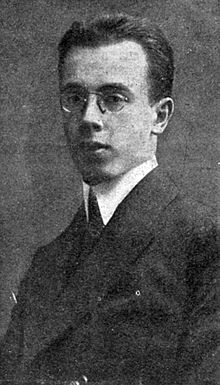Dmitrii Bogrov
This article needs additional citations for verification. (April 2014) |

Dmitry Grigoriyevich Bogrov (1887 – 24 September 1911) (Template:Lang-ru) was the assassin of the Russian Prime Minister Pyotr Stolypin.
Born Mordekhai Gershkovich Bogrov (Template:Lang-ru)[citation needed] into a family of Jewish merchants in Kiev (Russian Empire), Bogrov, while simultaneously acting as an anarchist revolutionary, had been an agent of the Okhrana secret police since 1906, informing on the activities of Socialist Revolutionaries, Social Democrats and anarchists.[1]
On 14 September 1911, Dmitry Bogrov shot the Russian prime minister Pyotr Stolypin, in the Kiev Opera House, in front of Tsar Nicholas II and two of his daughters. Stolypin died four days later. This act was committed ostensibly in order to decapitate a successful and popular conservative reform movement and thus hasten violent revolution. However, it has been alleged[by whom?] that Bogrov was permitted to act at the behest of extreme right-wing elements in the Tsarist secret police who detested Stolypin because of his agrarian reforms and his flair for parliamentary government. (Aleksandr Solzhenitsyn extensively investigates and gives full credit to this conjecture in his historical novel August 1914.)
Bogrov was tried by the district military court. Despite the plea of Stolypin's widow to the court to save Bogrov's life (she said that taking the young man's life would not bring her husband back), Bogrov was sentenced to death and executed by hanging on September 24 [O.S. September 11] 1911 in the Kiev fortress of Lysa Hora.
Significantly, the investigation of Stolypin's assassination was later discontinued at the express order of Nicholas II.[citation needed]
References
- ^ Riasanovsky, Nicholas V., and Mark D. Steinberg. A history of Russia. Oxford University Press, 2011, p. 412.
- 1887 births
- 1911 deaths
- People from Kiev
- People from Kiev Governorate
- Ukrainian Jews
- Ukrainian anarchists
- Okhrana informants
- Assassins of heads of government
- Ukrainian assassins
- People convicted of murder by Russia
- Ukrainian people convicted of murder
- People executed by the Russian Empire
- Ukrainian people executed by hanging
- Ukrainian revolutionaries
- Ukrainian history stubs
- Russian history stubs
